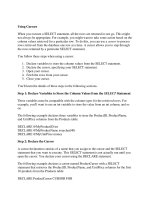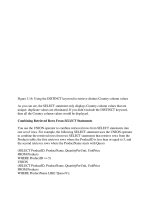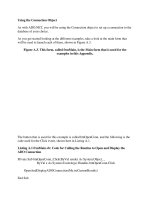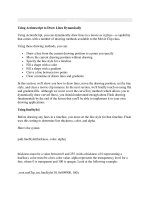Tài liệu Using Rose Rational Rose ppt
Bạn đang xem bản rút gọn của tài liệu. Xem và tải ngay bản đầy đủ của tài liệu tại đây (2.27 MB, 258 trang )
Rational the e-development company™
Using Rose
Rational Rose
®
VERSION: 2001A.04.00
P
ART NUMBER: 800-024462-000
COPYRIGHT NOTICE
Copyright
2000 Rational Software Corporation. All rights reserved.
THIS DOCUMENT IS PROTECTED BY COPYRIGHT AND CONTAINS INFORMATION PROPRIETARY
TO RATIONAL. ANY COPYING, ADAPTATION, DISTRIBUTION, OR PUBLIC DISPLAY OF THIS
DOCUMENT WITHOUT THE EXPRESS WRITTEN CONSENT OF RATIONAL IS STRICTLY
PROHIBITED. THE RECEIPT OR POSSESSION OF THIS DOCUMENT DOES NOT CONVEY ANY
RIGHTS TO REPRODUCE OR DISTRIBUTE ITS CONTENTS, OR TO MANUFACTURE, USE, OR SELL
ANYTHING THAT IT MAY DESCRIBE, IN WHOLE OR IN PART, WITHOUT THE SPECIFIC WRITTEN
CONSENT OF RATIONAL.
U.S. GOVERNMENT RIGHTS NOTICE
U.S.GOVERNMENTRIGHTS.Use,duplication,ordisclosurebytheU.S.Governmentissubjectto
restrictions set forth in the applicable Rational License Agreement and in DFARS 227.7202-1(a) and
227.7202-3(a) (1995), DFARS 252.227-7013(c)(1)(ii) (Oct 1988),FAR 12.212(a) 1995, FAR 52.227-19, or FAR
52.227-14, as applicable.
TRADEMARK NOTICE
Rational, the Rational logo,Rational Rose,ClearCase, and Rational Unified Process are trademarks or
registered trademarks of Rational Software Corporation in the United States and in othercountries.
Visual C++, Visual Basic, Windows NT, Developer Studio, and Microsoft are trademarks or registered
trademarks of the Microsoft Corporation. BasicScript is a trademark of Summit Software, Inc. All other
names are used for identification purposes only and are trademarks or registered trademarks of their
respective companies.
Portions ofRational Rose include source code from Compaq Computer Corporation; Copyright 2000
Compaq Computer Corporation.
U.S. Registered Patent Nos. 5,193,180 and 5,335,334 and 5,535,329. Licensed under Sun Microsystems Inc.’s
U.S. Pat. No. 5,404,499. Other U.S. and foreign patents pending.
Printed in the U.S.A.
Contents iii
Preface xxi
Audience xxi
OtherResources xxi
Contacting Rational Technical Publications . . . xxi
Contacting Rational Technical Support . xxii
1 IntroductiontoVisualModelingUsingRationalRose 1
Contents 1
Overview 1
Visual Modeling 1
Modeling with Rational Rose . 3
Notations 3
Features 4
Extending Rational Rose 4
2 GettingStartedwithRationalRose 7
Contents 7
Overview 7
Application Window. . . 9
TitleBar 9
Control-MenuBox 9
Minimize,Restore,andCloseButtons 10
MenuBar 10
Toolbar 10
Toolbox 13
CustomizingtheToolbox 14
Browser 14
DocumentationWindow 14
LogWindow 15
DiagramWindow 16
OverviewWindow 16
Specification Window . 17
PrintingDiagramsandSpecifications 17
PrintPreview 18
Contents
iv Contents
ApplyFilterDialogBox 18
SavinginVariousFormats 19
3 TheBrowser 21
Contents 21
Overview 21
ViewingtheBrowser 21
HidingandDisplayingtheBrowser 22
PositioningtheBrowser 22
DockingandUndockingtheBrowser 22
NavigatingaModel 23
Expanding and Collapsing the Browser Tree . . 24
CreatingandEditingModelElements 24
NaminganElementintheBrowser 24
SelectingMultipleElementsintheBrowser 25
Sorting Packages in the Browser 26
Using Drag-and-Drop in the Browser 26
BrowsertoBrowserCapabilities 27
BrowsertoDiagramCapabilities 28
Browser to Specification Capabilities . . 29
4 IntroductiontoDiagrams 31
Contents 31
Overview 31
DiagramWindows 32
ViewingDiagrams 32
DisplayingMultipleDiagrams 33
Creating, Linking, Displaying, Renaming, and Deleting Diagrams . . 34
CreatingaNewDiagram 34
LinkingaDiagram 35
DisplayingaDiagram 35
Renaming a Diagram . 35
DeletingaDiagram 36
CreatingandNamingModelElements 36
CreatinganElementontheDiagram 36
CreatinganElementintheBrowser 36
Naming Model Elements 36
ReassigningModelElements 38
ManipulatingIcons 39
Contents v
SelectingIcons 39
DeselectingIcons 40
ResizinganIcon 40
MovingOneorMoreIcons 40
Changing from One Kind of Element or Relationship to Another. . . 41
Cutting,Copying,andPastingIcons 41
Deleting Model Elements 42
ShallowDelete 42
DeepDelete 42
Correlations 43
CreatingCorrelationsBetweenElements 43
Bending a Correlation Icon 43
Reconnecting a Correlation Icon from One Icon to Another 44
NamingaCorrelation 44
LayingOutaDiagram 44
Laying Out All Shapes in a Diagram 45
LayingOutSelectedShapesinaDiagram 46
AdorningtheDiagrams 46
PlacingTextinaDiagram 46
ManipulatingText 46
Understanding Model Workspaces 47
Differences Between a Saved Model and a Model Workspace 47
Model Workspace Scenario 48
SavingaModelWorkspace 49
Loading a Model Workspace 49
5 IntroductiontoSpecifications 51
Contents 51
Overview 51
DisplayingSpecifications 51
CustomSpecifications 52
EditingSpecifications 52
CommonSpecificationElements 53
DialogBoxes 53
GeneralTab 53
DetailTab 55
FilesTab 55
TabButtons 57
vi Contents
NavigatingtheTabs 58
AddingandDeletingEntries 58
EditingEntries 58
6 ClassDiagramsandSpecifications 59
Contents 59
ClassDiagramOverview 59
ClassDiagramToolbox 60
CreatingandDisplayingaClassDiagram 61
Assigning a Class to Another Logical Package 61
AddingandHidingClassesandFilteringClassRelationships 62
ClassSpecification 62
Class Specification—General Tab 63
Type 63
Parent 64
Stereotype 64
ExportControl 64
ClassSpecification—DetailTab 65
Cardinality 66
Space 66
Persistence 67
Concurrency 68
Abstract 68
FormalArguments 68
ClassSpecification—OperationsTab 69
ShowInherited 70
ClassSpecification—AttributesTab 71
ClassSpecification—RelationsTab 73
ClassSpecification—ComponentTab 74
ClassSpecification—NestedTab 75
ClassSpecification—FilesTab 77
ClassAttributeSpecification 77
Class Attribute—General Tab . 78
Class 78
ShowClasses 78
Type 78
InitialValue 79
ClassAttribute—DetailTab 79
Containment 79
Static 80
Contents vii
Derived 80
OperationSpecification 80
OperationSpecification—GeneralTab 81
ReturnType 81
OperationSpecification—DetailTab 82
Arguments 82
Protocol 82
Qualifications 83
Exceptions 83
Size 83
Time 83
Concurrency 83
Operation Specification—Preconditions Tab 84
Preconditions 84
InteractionDiagram 84
OperationSpecification—SemanticsTab 85
Semantics 85
InteractionDiagram 85
OperationSpecification—PostconditionsTab 86
Postconditions 86
InteractionDiagram 86
OperationSpecification—FilesTab 86
ParameterSpecification 87
DefiningaNewParameter 87
Parameter Specification—General Tab . . . 88
Default 88
Owner 88
Type 88
AssociationSpecification 89
AssociationSpecification—GeneralTab 89
Parent 89
Stereotype 90
Role 90
Element 90
AssociationSpecification—DetailTab 90
Derived 91
LinkElement 91
NameDirection 91
Constraints 91
Association Specification—Role B General Tab . . 92
viii Contents
AssociationSpecification—RoleAandBDetailTab 93
Navigable 93
Aggregate 93
Static 94
Friend 94
Containmentof 94
Keys/Qualifiers 95
GeneralizeSpecification 95
Generalize Specification—General Tab 95
Friendship Required 96
VirtualInheritance 96
RealizeSpecification 96
RealizeSpecification—GeneralTab 96
Dependency Specification. 97
Dependency Specification—General Tab 97
HasRelationship(BoochOnly) 98
Has Specification—General Tab 98
HasSpecification—DetailTab 99
Key/QualifierSpecification 99
DefiningaNewKey/Qualifier 99
Key/Qualifier Specification—General Tab 100
Owner 100
7 Use-CaseDiagramsandSpecifications 101
Contents 101
Use-CaseDiagramOverview 101
Actors 102
UseCase 102
FlowofEvents 103
Relationships 103
Association 103
Dependency . 104
ExtendStereotype 104
IncludeStereotype 104
RefineStereotype 105
Generalization 105
Use-CaseDiagramToolbox 105
Use-CaseSpecification 106
Use-Case Specification—General Tab . 107
Name 107
Contents ix
Package 107
Rank 107
Abstract 108
Use-CaseSpecification—DiagramTab 108
DiagramList 108
Use-CaseSpecification—RelationsTab 109
Relations 109
GeneralizeSpecification 109
Generalize Specification—General Tab . . . 110
Stereotype 110
Friendship Required . 110
VirtualInheritance 111
ActorSpecification 111
8 StateMachineDiagramsandSpecifications 113
Contents 113
Overview 114
CreatingandDisplayingaStateMachineDiagram 114
StateMachineSpecification 114
StateMachineSpecification—GeneralTab 115
StatechartDiagramOverview 115
CreatingaStatechartDiagram 116
AutomaticTransmissionExample 117
ActivityDiagramOverview 118
UsingActivityDiagrams 118
Understanding Workflows 118
CreatinganActivityDiagram 119
WorkflowModeling 119
PurposesofWorkflowModeling 119
DefiningaWorkflow 120
ModelingaWorkflowwithanActivityDiagram 121
Activity Diagram-Specific Model Elements 122
Activities 122
Swimlanes 122
Objects 122
ObjectFlow 123
Understanding Objects and Object Flows . 124
Changing the State of an Object 125
SharedStateMachineDiagramModelElements 125
xContents
States 125
StartandEndStates 125
Transitions 126
TransitiontoSelf 126
Decisions 126
Synchronizations 126
SwimlaneSpecification 127
Swimlane Specification—General Tab . 127
StateandActivitySpecification 128
State and Activity Specification—General Tab . 128
StateandActivitySpecification—ActionsTab 129
Type 129
ActionExpression 130
StateandActivitySpecification—TransitionsTab 130
StateandActivitySpecification—SwimlanesTab 131
ActionSpecification 131
StateTransitionSpecification 133
State Transition Specification—General Tab . . 133
TransitionSpecification—DetailTab 134
GuardCondition 134
TransitionBetweenSubstates 134
DecisionSpecification 135
DecisionSpecification—GeneralTab 135
DecisionSpecification—TransitionsTab 136
Decision Specification—Swimlanes Tab 137
SynchronizationSpecification 137
Synchronization Specification—General Tab . . 138
SynchronizationSpecification—TransitionsTab 139
ObjectSpecification(ActivityDiagrams) 139
Object Specification—General Tab 140
ObjectSpecification—IncomingObjectFlowsTab 141
ObjectSpecification—OutgoingObjectFlowsTab 142
ObjectFlowSpecification 142
ObjectFlowSpecification—GeneralTab 143
9 InteractionDiagramsandSpecifications 145
Contents 145
InteractionDiagramOverview 145
CreatingandDisplayinganInteractionDiagram 146
Contents xi
CollaborationDiagrams 146
Sequence Diagrams . . 147
Toolboxes 148
CollaborationDiagramToolbox 148
Sequence Diagram Toolbox 149
Common Collaboration and Sequence Diagram Icons 150
Object 150
Messages 151
MessageNumbering 152
AssigninganOperationtoaMessage 152
Collaboration-SpecificToolboxIcons 153
Links 153
Sequence Numbering. 154
Top-LevelNumbering 154
HierarchicalNumbering 154
Scripts 155
FocusofControl 156
DisplayingFocusofControl 157
ColoringFocusofControl 157
MovingtheFocusofControl 157
NestedFocusofControl 157
ObjectConstructionandDestruction 158
ObjectConstructionMarkers 158
ObjectDestructionMarkers 159
CreatingAlternativeDiagrams 159
Toggling Between Interaction Diagrams. . . 159
Creating a Collaboration Diagram from a Sequence Diagram 159
Creating a Sequence Diagram from a Collaboration Diagram 159
ObjectSpecification(InteractionDiagrams) 160
Object Specification—General Tab 160
Name 160
Class 161
PersistenceField 161
MultipleInstancesCheckBox 161
ClassInstanceSpecifications 161
Class Instance Specification—General Tab 162
Class 162
LinkSpecification 163
xii Contents
Link Specification—General Tab 163
Assoc 164
Supplier and Client Visibility 164
Shared 165
Role 165
Link Specification—Messages Tab 166
Icon 166
Sequence 166
MessageName 166
Receiver 167
MessageSpecification 167
MessageSpecificationGeneralTab 167
Class 168
MessageSpecification—DetailTab 168
Synchronization 169
Frequency 170
10ComponentDiagramsandSpecifications 171
Contents 171
Component Diagram Overview. . . 171
CreatingandDisplayingaComponentDiagram 172
Component Diagram Toolbox . 172
Assigning a Component to Another Package. . 172
Component Specification . 173
Component Specification—General Tab 174
Stereotype (Component) . 174
Language 174
Component Specification—Detail Tab . 175
Declarations 175
Component Specification—Realizes Tab 176
ShowAllClasses 176
Classes 176
Language 177
Component Specification—Files Tab . . 177
PackageSpecification 177
Package Specification—General Tab . . 178
Package 178
PackageSpecification—DetailTab 179
Component Diagrams . . . 179
PackageSpecification—RealizesTab 179
Contents xiii
PackageSpecification—FilesTab 179
11 DeploymentDiagramsandSpecifications 181
Contents 181
DeploymentDiagramOverview 181
CreatingandDisplayingaDeploymentDiagram 182
DeploymentDiagramToolbox 182
ProcessorSpecification 182
Processor Specification—General Tab . . . 183
ProcessorSpecification—DetailTab 184
Characteristics 184
Processes 184
Scheduling 185
DeviceSpecification 185
Device Specification—General Tab 186
DeviceSpecification—DetailTab 187
Connection Specification 187
ProcessSpecification 188
Process Specification—General Tab 188
Processor 189
Priority 189
12Stereotypes 191
Contents 191
Overview 191
Benefits to Using Stereotypes 192
User-DefinedStereotypes 192
ViewingStereotypes 192
DiagramTab 193
BrowserTab 194
CreatingStereotypes 195
CreatingaNewStereotypefortheCurrentModel 195
CreatingaNewStereotypeConfigurationFile 195
Creating a New Stereotype for All Rose Models . . 196
CreatingStereotypeIcons 197
CreatingaDiagramIcon 198
CreatingDiagramToolboxandListViewIcons 198
AddingStereotypestotheDiagramToolbox 199
SubsystemStereotypePackage 200
xiv Contents
SubsystemStereotypeSample 200
13FrameworkWizardAdd-In 201
Contents 201
Overview 201
ActivatingtheFrameworkWizardAdd-In 202
Creating a New Model from a Framework . 202
CreatingandDeletingFrameworks 203
TheFrameworkLibrary 204
CreatingaNewFramework 205
Changing or Deleting a Framework . . . 206
14TypeLibraryImporter 207
Contents 207
Overview 207
WhatIsaTypeLibrary? 208
Why Would I Want to Import Type Libraries into the Model? 208
What COM Components Can Be Imported into the Model? 209
HowIsaTypeLibraryPresented? 209
A Type Library in Rational Rose 209
TypeLibraryintheOLEViewerinVisualStudio 214
TypeLibraryintheObjectBrowserinVisualBasic 215
ImportingaTypeLibraryintotheModel 216
ImportingaNewVersionofanExistingTypeLibrary 217
HidingTypeLibraryItems 218
Show Hidden Items Selected . 218
Show Hidden Items Cleared. . 219
UsinganImportedTypeLibrary 220
AddingClassMemberstoaQuickImportTypeLibrary 220
CustomizingtheTypeLibraryImporter 221
A UpgradingfromaPreviousRelease 225
Contents 225
UpgradingfromRationalRose3.0orLater 225
UpgradingfromReleasesPriortoRationalRose3.0 225
Understanding Petal File Versions 225
Index 227
Figures xv
Figure 1 Application Window 9
Figure 2 Standard Toolbar . 10
Figure 3 Application Window 22
Figure 4 Navigating a Model 23
Figure 5 Browser—Collapsed and Expanded Tree . 24
Figure6 DiagramWindow 33
Figure7 MultipleDiagrams—CascadeWindows 33
Figure8 MultipleDiagrams—TiledWindows 34
Figure9 SelectedElementsinaDiagram 39
Figure10 ExampleLayoutofaClassDiagram 45
Figure 11 Model Workspace Loaded Units . . 48
Figure12 GeneralTab 53
Figure13 DetailTab 55
Figure14 FilesTab 56
Figure15 TabButtons 57
Figure16 ClassDiagramExample 60
Figure17 ClassDiagramToolbox 61
Figure 18 Class Specification—General Tab . 63
Figure19 ClassSpecification—DetailTab 65
Figure20 ClassSpecification—OperationsTab 69
Figure21 ClassSpecification—AttributesTab 71
Figure22 ClassSpecification—RelationsTab 73
Figure23 ClassSpecification—ComponentTab 74
Figure24 ClassSpecification—NestedTab 75
Figure 25 Class Attribute—General Tab 78
Figure26 ClassAttribute—DetailTab 79
Figure27 OperationsSpecification—GeneralTab 81
Figure28 OperationSpecification—DetailTab 82
Figure 29 Operation Specification—Preconditions Tab 84
Figure30 OperationsSpecification—SemanticsTab 85
Figure31 OperationSpecification—PostconditionsTab 86
Figure 32 Parameter Specification—General Tab . . . 88
Figure33 AssociationSpecification—GeneralTab 89
Figure34 AssociationSpecification—DetailTab 90
Figure35 AssociationSpecification—RoleAandBGeneralTab 92
Figure36 AssociationSpecification—RoleAandBDetailTab 93
Figures
xvi Figures
Figure 37 Generalize Specification—General Tab 95
Figure38 RealizeSpecification—GeneralTab 96
Figure 39 Dependency Specification—General Tab 97
Figure 40 Has Specification—General Tab 98
Figure41 HasSpecification—DetailTab 99
Figure 42 Key/Qualifier Specification—General Tab 100
Figure43 UseCaseDiagramToolbox 106
Figure 44 Use-Case Specification—General Tab 107
Figure45 Use-CaseSpecification—DiagramTab 108
Figure46 Use-CaseSpecification—RelationsTab 109
Figure 47 Generalize Specification—General Tab 110
Figure48 StateMachineSpecification—GeneralTab 115
Figure49 AutomaticTransmissionExample 117
Figure50 ObjectsonanActivityDiagramSample 123
Figure51 ObjectFlowSample 124
Figure52 CDPlayerSample 124
Figure 53 Swimlane Specification—General Tab. 127
Figure 54 State and Activity Specification—General Tab. 128
Figure55 StateandActivitySpecification—ActionsTab 129
Figure56 StateandActivitySpecification—TransitionsTab 130
Figure57 StateandActivitySpecification—SwimlanesTab 131
Figure 58 State Transition Specification—General Tab . . 133
Figure59 StateTransitionSpecification—DetailTab 134
Figure60 DecisionSpecification—GeneralTab 135
Figure61 DecisionSpecification—TransitionsTab 136
Figure 62 Decision Specification—Swimlanes Tab 137
Figure 63 Synchronization Specification—General Tab. . 138
Figure64 SynchronizationSpecification—TransitionsTab 139
Figure 65 Object Specification—General Tab . . . 140
Figure66 ObjectSpecification—IncomingObjectFlowsTab 141
Figure67 ObjectSpecification—OutgoingObjectFlowsTab 142
Figure68 ObjectFlowSpecification—GeneralTab 143
Figure69 CollaborationDiagramExample 147
Figure 70 Sequence Diagram Example. . 148
Figure71 CollaborationDiagramToolbox 149
Figure 72 Sequence Diagram Toolbox . . 149
Figure73 MultipleObjectDiagram 150
Figure74 FocusofControlDiagramExample 156
Figure 75 Object Specification—General Tab . . . 160
Figure 76 Class Instance Specification—General Tab. . . 162
Figure 77 Link Specification—General Tab 163
Figures xvii
Figure 78 Link Specification—Messages Tab 166
Figure79 MessageSpecificationGeneralTab 167
Figure80 MessageSpecification—DetailTab 168
Figure 81 Component Diagram Example . . . 171
Figure 82 Component Diagram Toolbox 172
Figure 83 Component Specification—General Tab. . 174
Figure 84 Component Specification—Detail Tab 175
Figure 85 Component Specification—Realizes Tab . 176
Figure 86 Package Specification—General Tab 178
Figure87 PackageSpecification—DetailTab 179
Figure88 DeploymentDiagramExample 181
Figure89 DeploymentDiagramToolbox 182
Figure 90 Processor Specification—General Tab . . . 183
Figure91 ProcessorSpecification—DetailTab 184
Figure 92 Device Specification—General Tab 186
Figure93 DeviceSpecification—DetailTab 187
Figure 94 Process Specification—General Tab 188
Figure95 OptionsDialogBox—DiagramTab 193
Figure96 OptionsDialogBox—BrowserTab 194
Figure97 SubsystemStereotypeSample 200
Figure 98 Create New Model Dialog Box . . . 203
Figure99 FrameworkWizardSpecificationPage 205
Figure100 FrameworkWizardSummaryPage 206
Figure 101 Component View of the Microsoft Scripting Runtime Type Library . . . 209
Figure 102 Component Overview Diagram for a Model 210
Figure 103 Logical View of the Microsoft Scripting Runtime Type Library 211
Figure 104 Overview Diagram of the Microsoft Scripting Runtime Type Library. . 212
Figure105 OLEViewerinVisualStudio 215
Figure106 ObjectBrowserinVisualBasic 216
Figure107 TypeLibrarywithShowHiddenItemsOptionSelected 218
Figure108 TypeLibrarywithShowHiddenItemsOptionCleared 219
Figure109 COMPropertiesDialogBox 221
Tables xix
Table1 PrintDialogBoxTabs 17
Table2 BrowsertoBrowserCapabilities 27
Table3 BrowsertoDiagramCapabilities 28
Table 4 Browser to Specification Capabilities 29
Table5 ExportControlFieldOptions 64
Table6 CardinalityFieldOptions 66
Table7 PersistenceFieldOptions 67
Table8 ClassConcurrencyOptions 68
Table9 PhysicalContainmentOptions 79
Table10 ConcurrencyFieldOptions 83
Table11 ContainmentFieldOptions 94
Table12 PersistenceFieldOptions 161
Table 13 Supplier and Client Visibility Options 164
Table14 SynchronizationOptions 169
Table15 FrequencyOptions 170
Table16 SchedulingFieldOptions 185
Table17 COMStereotypes 213
Table 18 Rational Rose Petal File Version . 226
Tables
xxi
Preface
This manual provides an introduction to Rational Rose. Rational Rose is the visual
modeling tool that is part of a comprehensive set of tools that embody software
engineering best practices and span the entire software development life cycle.
Rational Rose helps improve communication both within teams and across team
boundaries, reducing development time and improving software quality.
Audience
This guide is intended for all users of Rational Rose, including administrators,
analysts, architects, and developers.
Other Resources
■
Online Help is available for Rational Rose and its add-ins. In Rational Rose, select
an option from the
Help menu.
■
Manuals for Rational Rose and its add-ins are available. All manuals are available
online in either HTML or PDF format. The online manuals are on the Rational
Solutions for Windows Online Documentation CD.
■
A Rational Rose tutorial is available for Rational Rose. The tutorial is on the
Rational Solutions for Windows Online Documentation CD.
■
For more information on training opportunities, see the Rational University Web
site:
/>Contacting Rational Technical Publications
To send feedback about documentation for Rational products, please send e-mail to
our Technical Documentation department at
xxii Preface
Contacting Rational Technical Support
If you have questions about installing, using, or maintaining this product, contact
Rational Technical Support.
Note: When you contact Rational Technical Support, please be prepared to supply the
following information:
■
Your name, telephone number, and company name
■
Your computer’s make and model
■
Your operating system and version number
■
Product release number and serial number
■
Your case ID number (if you are following up on a previously-reported problem)
Your Location Telephone Fax E-mail
North America (800) 433-5444
(toll free)
(408) 863-4000
Cupertino, CA
(781) 676-2460
Lexington, MA
Europe, Middle
East, Africa
+31 (0) 20-4546-200
Netherlands
+31 (0) 20-4545-201
Netherlands
Asia Pacific +61-2-9419-0111
Australia
+61-2-9419-0123
Australia
1
1
Introduction to Visual
Modeling Using Rational
Rose
Contents
This chapter is organized as follows:
■
Overview on page 1
■
Visual Modeling on page 1
■
Modeling with Rational Rose on page 3
■
Notations on page 3
■
Features on page 4
■
Extending Rational Rose on page 4
Overview
Rational Rose provides support for two essential elements of modern software
engineering: component-based development and controlled iterative development.
While these concepts are conceptually independent, their usage in combination is
both natural and beneficial.
Rational Rose’s model-diagram architecture facilitates use of the Unified Modeling
Language (UML), Component Object Modeling (COM), Object Modeling Technique
(OMT), and Booch ‘93 method for visual modeling. Using semantic information
ensures correctness by construction and maintaining consistency.
Visual Modeling
Increasing complexity, resulting from a highly competitive and ever-changing
business environment, offers unique challenges to system developers. Models help
you organize, visualize, understand, and create complex things.
Visual modeling is the mapping of real world processes of a system to a graphical
representation. Models are useful for understanding problems, communicating with
everyone involved with the project (customers, domain experts, analysts, designers,
2 Chapter 1 - Introduction to Visual Modeling Using Rational Rose
etc.), modeling complex systems, preparing documentation, and designing programs
and databases. Modeling promotes better understanding of requirements, cleaner
designs, and more maintainable systems.
As software systems become more complex, we cannot understand them in their
entirety. To effectively build a complex system, the developer begins by looking at the
big picture without getting caught up in the details. A model is an ideal way to
portray the abstractions of a complex problem by filtering out nonessential details.
The developer must abstract different views or blueprints of the system, build models
using precise notations, verify that the models satisfy the requirements of the system,
and gradually add detail to transform the models into an implementation.
The models of a software system are analogous to the blueprints of a building. An
architect could not design a structure in its entirety with one blueprint. Instead a
blueprint is drawn up for the electrician, the plumber, the carpenter, and so on. When
designing a software system, the software engineer deals with similar complexities.
Different models are drawn up to serve as blueprints for marketing, software
developers, system developers, quality assurance engineers, etc. The models are
designed to meet the needs of a specific audience or task, thereby making them more
understandable and manageable.
Visual modeling has one communication standard: the Unified Modeling Language
(UML). The UML provides a smooth transition between the business domain and the
computer domain. Using the UML, all members of a design team can work with a
common vocabulary, minimizing miscommunication and increasing efficiency.
Visual modeling captures business processes by defining the software system
requirements from the user’s perspective. This streamlines the design and
development process. Visual modeling also defines architecture by providing the
capability to capture the logical software architecture independent of the software
language. This method provides flexibility to your system design since the logical
architecture can always be mapped to a different software language. Finally, with
visual modeling, you can reuse parts of a system or an application by creating
components of your design. These components can then be shared and reused by
different members of a team allowing changes to be easily incorporated into already
existing development software.
Modeling with Rational Rose 3
Modeling with Rational Rose
Rational Rose is the visual modeling software solution that lets you create, analyze,
design, view, modify, and manipulate components. You can graphically depict an
overview of the behavior of your system with a use-case diagram. Rational Rose
provides the collaboration diagram as an alternative to a use-case diagram. It shows
object interactions organized around objects and their links to one another. The
statechart diagram provides additionalanalysis techniques for classes with significant
dynamic behavior. A statechart diagram shows the life history of a given class, the
events that cause a transition from one state to another, and the actions that result
from a state change. Activity diagrams provide a way to model a class operation or
the workflow of a business process.
Rational Rose provides the notation needed to specify and document the system
architecture. The logical architecture is captured in class diagrams that contain the
classes and relationships that represent the key abstractions of the system under
development. The component architecture is captured in component diagrams that
focus on the actual software module organization within the development
environment. The deployment architecture is captured in deployment diagrams that
map software to processingnodes—showing theconfigurationofrun-timeprocessing
elements and their software processes.
Notations
Notation plays an important part in any application development activity—it is the
glue that holds the process together. UML provides a very robust notation, which
grows from analysis into design. Certain elements of the notation (that is, use cases,
classes, associations, aggregations, inheritance) are introduced during analysis. Other
elements of the notation (that is, containment indicators and properties) are
introduced during design.
Notation has the following roles:
■
Communicates decisions that are not obvious or cannot be inferred from the code
itself
■
Provides semantics that capture important strategic and tactical decisions
■
Offers concrete forms and tools that can be manipulated









